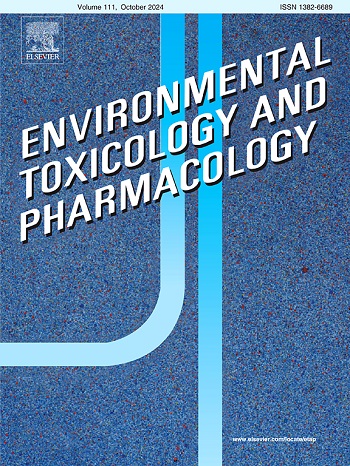Multi-biomarker approach to assess the toxicity of carbamazepine, a neuropharmaceutical, in the female fish Astyanax lacustris (Teleostei: Characidae)
IF 4.2
3区 环境科学与生态学
Q2 ENVIRONMENTAL SCIENCES
引用次数: 0
Abstract
Carbamazepine (CBZ) is a pharmaceutical commonly used in the treatment of epilepsy and bipolar disorder and has been detected in different aquatic ecosystems worldwide. Considering its possible role in altering nervous system and reproduction, this study aimed to evaluate the effects of CBZ on molecular and cellular biomarkers of the teleost Astyanax lacustris. Results demonstrated that CBZ, in environmentally relevant concentrations (500 ng L−1) increases fshβ gene expression levels, decreases muscle protein content and hepatic LPO (500 ng L−1 and 1250 ng L−1 of CBZ). Nonetheless, no effects were observed towards enzymatic activities, steroid plasma levels and/or lipid content. Considering that A. lacustris inhabits clean and polluted environments, it is possible to suggest that animals possess a level of tolerance to stressors, allowing them to maintain reproductive functions regardless of environmental challenges.
求助全文
约1分钟内获得全文
求助全文
来源期刊
CiteScore
7.00
自引率
4.70%
发文量
185
审稿时长
34 days
期刊介绍:
Environmental Toxicology and Pharmacology publishes the results of studies concerning toxic and pharmacological effects of (human and veterinary) drugs and of environmental contaminants in animals and man.
Areas of special interest are: molecular mechanisms of toxicity, biotransformation and toxicokinetics (including toxicokinetic modelling), molecular, biochemical and physiological mechanisms explaining differences in sensitivity between species and individuals, the characterisation of pathophysiological models and mechanisms involved in the development of effects and the identification of biological markers that can be used to study exposure and effects in man and animals.
In addition to full length papers, short communications, full-length reviews and mini-reviews, Environmental Toxicology and Pharmacology will publish in depth assessments of special problem areas. The latter publications may exceed the length of a full length paper three to fourfold. A basic requirement is that the assessments are made under the auspices of international groups of leading experts in the fields concerned. The information examined may either consist of data that were already published, or of new data that were obtained within the framework of collaborative research programmes. Provision is also made for the acceptance of minireviews on (classes of) compounds, toxicities or mechanisms, debating recent advances in rapidly developing fields that fall within the scope of the journal.

 求助内容:
求助内容: 应助结果提醒方式:
应助结果提醒方式:


